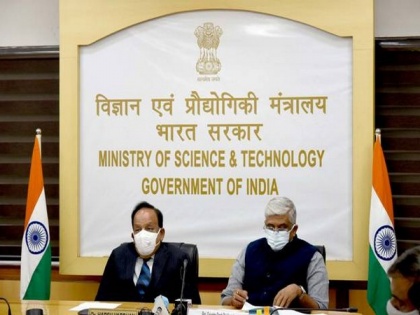CGWB, CSIR-NGRI sign MoA for high-resolution aquifer mapping and management
By ANI | Published: December 22, 2020 08:28 AM2020-12-22T08:28:27+5:302020-12-22T08:35:13+5:30
A Memorandum of Agreement (MoA) was signed between Central Ground Water Board and CSIR-NGRI for high-resolution aquifer mapping and management in arid region of the north-western part of the country here on Monday.

CGWB, CSIR-NGRI sign MoA for high-resolution aquifer mapping and management
A Memorandum of Agreement (MoA) was signed between Central Ground Water Board and CSIR-NGRI for high-resolution aquifer mapping and management in arid region of the north-western part of the country here on Monday.
In a statement, the Ministry of Jal Shakti said: "An MoA was signed between Central Ground Water Board (CGWB), Ministry of Jal Shakti and CSIR-NGRI, Hyderabad for use of advanced heliborne geophysical survey and other scientific studies in parts of the States of Rajasthan, Gujarat and Haryana under the aquifer mapping programme."
The MoA was signed by Chairman, CGWB and Director, CSIR-NGRI in presence of the Union Minister of Jal Shakti Gajendra Singh Shekhawat, and Union Minister of Science and Technology, Health and Family Welfare and Earth Sciences Harsh Vardhan.
Under phase-I of the project, an area of nearly 1 lakh square kilometre spreading over nearly 65,500 sq km of western arid Rajasthan, covering parts of Bikaner, Churu, Jalor, Pali, Jaisalmer, Jodhpur and Sikar districts, 32,000 square kilometre arid parts of Gujarat, covering Rajkot, Jamnagar, Morbi, Surendranagar and Devbhumi Dwarka districts and nearly 2500 sq km of Haryana, covering Kurukshetra and Yamuna Nagar districts will be covered at an estimated cost of Rs 54 crores.
The major objectives of the study include high-resolution aquifer mapping using heliborne geophysical studies, aquifer geometry of principal aquifer with demarcation of de-saturated and saturated aquifers, aquifer system with relatively fresh and saline zones and selecting suitable sites for groundwater withdrawal and water conservation through artificial or managed aquifer recharge.
"This is the first time the Ministry of Jal Shakti has decided to use the state of the art technology for identification of aquifers in such a large arid/semi-arid area of the country," the press statement read.
The study is likely to generate groundwater data in a very short time period and will help CGWB in expeditiously finalising the groundwater management plan in the water-stressed areas. The findings of the study will help in formulating site-specific plans for improving groundwater levels in the water-stressed areas and charter the road map for sustainable management of groundwater resources, it added.
( With inputs from ANI )
Disclaimer: This post has been auto-published from an agency feed without any modifications to the text and has not been reviewed by an editor
Open in app